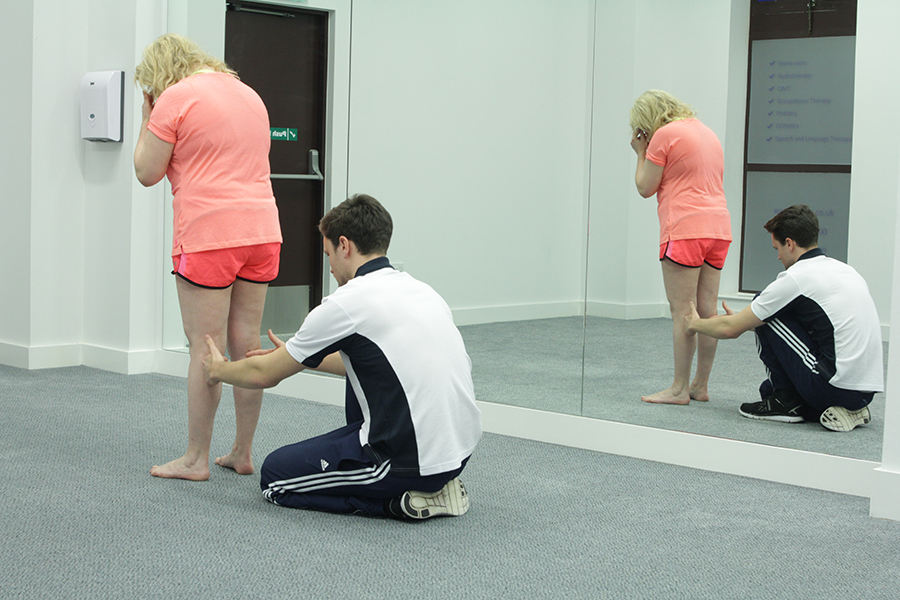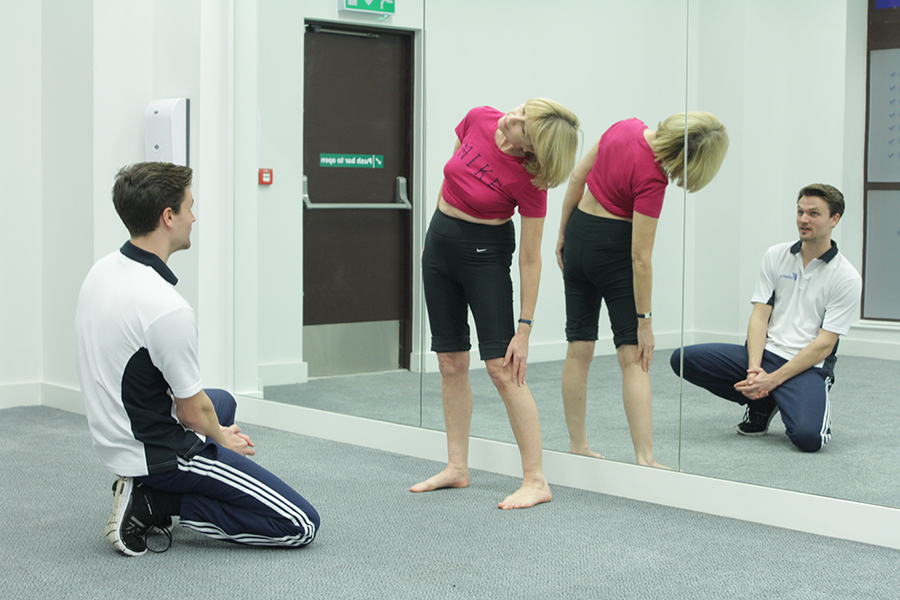Scoliosis
A scoliosis describes a sideways curvature of the spine. A scoliosis of the spine is the most common type of spinal curvature.
At Chiropody.co.uk we can help you if you have a functional scoliosis, by providing you with a treatment plan that will improve the deformity and reduce your symptoms.
A scoliosis is not an illness or medical condition, but a descriptive term that is used for a sideways 'S' or 'C' shaped curvature of the spine.
There are two types of scoliosis; structural or functional.
Structural Scoliosis
A structural scoliosis, also known as a 'true' scoliosis is progressive (will get worse over time) and is the most serious type of sideways curvature of the spine. A structural scoliosis means that the spine is fixed in shape, this means that the spine will not move out of its curved position. A true scoliosis occurs because there is unequal growth at either side of the vertebra, a structural scoliosis is therefore a bony abnormality.
Functional Scoliosis
A functional scoliosis is non-progressive and mobile, it can therefore be moved out of its curved position. A functional scoliosis is mobile because unlike a structural scoliosis, which is the result of a spinal abnormality, a functional scoliosis is caused by muscle imbalance.
A functional scoliosis can be corrected with help from podiatry, however, structural scoliosis requires surgery. The following section relates to functional scoliosis only.

A functional scoliosis is not the result of a bony abnormality of the spine, but instead the curve is the result of a problem elsewhere in the body, for example:
Leg length difference
When one leg is longer in length than the other a functional scoliosis will often develop as this causes the pelvis to tilt to one side, the spine then curves in order to maintain centre of gravity.
Muscle imbalance
Tight and/or lax muscles at one side of the body and muscle spasms can pull the spine into a curved position, creating a functional scoliosis.
Medical conditions
A number of medical conditions can produce a scoliosis of the spine. These include; rheumatic, metabolic, and connective tissue disorders, and arthritis.
The main contributing factor for a structural scoliosis appears to be genetic inheritance, however, the majority of cases are considered to be idiopathic; this means that the cause is unknown. Other causes of a structural scoliosis include:
The signs and symptoms of scoliosis are varied and are often dependent upon the severity of the curvature. The most common signs of scoliosis include:
A podiatrist is trained to diagnose a functional scoliosis. Their diagnosis is based on a thorough history taking, the physical signs and symptoms, such as un-level shoulder/arm height, and the spinal curve. The podiatrist will then examine the spine and assess leg length. The results of the history and examination will provide the podiatrist with the information necessary to establish if the scoliosis is structural or functional.

If you have a functional scoliosis podiatry may benefit you. A functional scoliosis is often the result of an actual leg length difference. A leg length difference affects the tilt of the pelvis, which affects the posture because the spine must curve in order to maintain centre of gravity.
Podiatry can help correct a functional scoliosis by improving the mechanics of the lower limb. Benefits achieved through podiatry include:
Podiatry for scoliosis would first involve obtaining a thorough history, which also includes a medical history. The podiatrist will then need to assess you, which includes an examination of the spine. The spinal examination is a very important part of the consultation as it will tell the podiatrist whether or not your scoliosis is functional or structural. Podiatry is only suitable for those who have a functional scoliosis; a structural scoliosis cannot be corrected with podiatry.
If you have a functional scoliosis it is essential that the podiatrist finds the underlying cause, they will therefore perform a biomechanical assessment and gait analysis.
Treatment for a functional scoliosis may include one or more of the following:
A scoliosis describes a sideways 'S' shaped or 'C' shaped curvature of the spine. There are two types of scoliosis; functional and structural. A structural scoliosis means that the curvature is caused by a bony abnormality; this means that the sideways curvature is due to an abnormality in the structure of the spine itself. A functional scoliosis is the result of a problem elsewhere in the body, such as a leg length difference or muscle tightness, which pulls the spine into a curved position.
Podiatry is only suitable for those who have a functional scoliosis; a structural scoliosis requires either surgery or bracing and needs to be referred to a specialist.
To book an assessment with one our podiatrists please Email office@chiropody.co.uk, or alternatively call us on 0330 088 4222.
At Chiropody.co.uk we can help you if you have a functional scoliosis, by providing you with a treatment plan that will improve the deformity and reduce your symptoms.
What is scoliosis?
A scoliosis is not an illness or medical condition, but a descriptive term that is used for a sideways 'S' or 'C' shaped curvature of the spine.
Types of scoliosis
There are two types of scoliosis; structural or functional.
Structural Scoliosis
A structural scoliosis, also known as a 'true' scoliosis is progressive (will get worse over time) and is the most serious type of sideways curvature of the spine. A structural scoliosis means that the spine is fixed in shape, this means that the spine will not move out of its curved position. A true scoliosis occurs because there is unequal growth at either side of the vertebra, a structural scoliosis is therefore a bony abnormality.
Functional Scoliosis
A functional scoliosis is non-progressive and mobile, it can therefore be moved out of its curved position. A functional scoliosis is mobile because unlike a structural scoliosis, which is the result of a spinal abnormality, a functional scoliosis is caused by muscle imbalance.
A functional scoliosis can be corrected with help from podiatry, however, structural scoliosis requires surgery. The following section relates to functional scoliosis only.

What causes scoliosis?
A functional scoliosis is not the result of a bony abnormality of the spine, but instead the curve is the result of a problem elsewhere in the body, for example:
Leg length difference
When one leg is longer in length than the other a functional scoliosis will often develop as this causes the pelvis to tilt to one side, the spine then curves in order to maintain centre of gravity.
Muscle imbalance
Tight and/or lax muscles at one side of the body and muscle spasms can pull the spine into a curved position, creating a functional scoliosis.
Medical conditions
A number of medical conditions can produce a scoliosis of the spine. These include; rheumatic, metabolic, and connective tissue disorders, and arthritis.
The main contributing factor for a structural scoliosis appears to be genetic inheritance, however, the majority of cases are considered to be idiopathic; this means that the cause is unknown. Other causes of a structural scoliosis include:
- Paralysis
- Neuromuscular conditions (e.g. cerebral palsy)
- Congenital (abnormal development of the bones that form the spine)
What are the signs and symptoms of scoliosis?
The signs and symptoms of scoliosis are varied and are often dependent upon the severity of the curvature. The most common signs of scoliosis include:
- An abnormal sideways curvature of the spine. The curve of the spine can affect either the upper or lower back, it can be mild or severe
- One hip appearing higher than the other
- One shoulder appearing higher than the other
- The head may appear off-centre
- Pain due to tight muscles
How is scoliosis diagnosed?
A podiatrist is trained to diagnose a functional scoliosis. Their diagnosis is based on a thorough history taking, the physical signs and symptoms, such as un-level shoulder/arm height, and the spinal curve. The podiatrist will then examine the spine and assess leg length. The results of the history and examination will provide the podiatrist with the information necessary to establish if the scoliosis is structural or functional.

Benefits of podiatry for a scoliosis
If you have a functional scoliosis podiatry may benefit you. A functional scoliosis is often the result of an actual leg length difference. A leg length difference affects the tilt of the pelvis, which affects the posture because the spine must curve in order to maintain centre of gravity.
Podiatry can help correct a functional scoliosis by improving the mechanics of the lower limb. Benefits achieved through podiatry include:
- Muscle re-balance
- Improvement in muscle alignment
- Improved gait
- Improved foot and lower limb function
- Reduction in painful symptoms
- Improvement in posture
What would podiatry for scoliosis involve?
Podiatry for scoliosis would first involve obtaining a thorough history, which also includes a medical history. The podiatrist will then need to assess you, which includes an examination of the spine. The spinal examination is a very important part of the consultation as it will tell the podiatrist whether or not your scoliosis is functional or structural. Podiatry is only suitable for those who have a functional scoliosis; a structural scoliosis cannot be corrected with podiatry.
If you have a functional scoliosis it is essential that the podiatrist finds the underlying cause, they will therefore perform a biomechanical assessment and gait analysis.
Treatment for a functional scoliosis may include one or more of the following:
- Orthoses
- Strengthening Exercises
- Stretching Programmes
- Advice and education
- Footwear review
- Heel raise
Summary
A scoliosis describes a sideways 'S' shaped or 'C' shaped curvature of the spine. There are two types of scoliosis; functional and structural. A structural scoliosis means that the curvature is caused by a bony abnormality; this means that the sideways curvature is due to an abnormality in the structure of the spine itself. A functional scoliosis is the result of a problem elsewhere in the body, such as a leg length difference or muscle tightness, which pulls the spine into a curved position.
Podiatry is only suitable for those who have a functional scoliosis; a structural scoliosis requires either surgery or bracing and needs to be referred to a specialist.
To book an assessment with one our podiatrists please Email office@chiropody.co.uk, or alternatively call us on 0330 088 4222.
Save 5% by booking an appointment online.

Find your nearest clinic
We have clinics located throughout the North West. We also provide a home visit service.
Find out more »

No waiting lists!
Tired of waiting for treatment? Be seen by a podiatrist today!
Find out more »

Not sure how we can help?
Speak to a podiatrist to find out how we can help. Call us on 0330 088 4222.
Find out more »
We work with:

Individuals

Organisations

Health professionals
Get in Touch!
0330 088 4222
If you would like to speak to one of our specialists then please complete this form.
We are open 7 days a week








